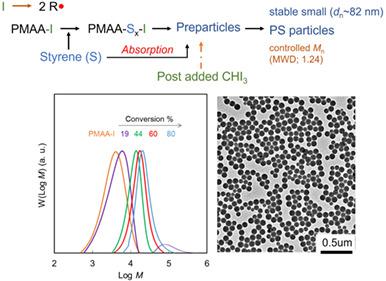当前位置:
X-MOL 学术
›
Polym. Int.
›
论文详情
Our official English website, www.x-mol.net, welcomes your feedback! (Note: you will need to create a separate account there.)
Emulsion iodine transfer polymerization of nearly uniform submicrometer-sized polystyrene particles
Polymer International ( IF 3.2 ) Pub Date : 2021-09-16 , DOI: 10.1002/pi.6300 Amorn Chaiyasat 1, 2 , Sawitree Sue‐eng 1 , Laurent Billon 3 , Masayoshi Okubo 2, 4 , Preeyaporn Chaiyasat 1, 2
Polymer International ( IF 3.2 ) Pub Date : 2021-09-16 , DOI: 10.1002/pi.6300 Amorn Chaiyasat 1, 2 , Sawitree Sue‐eng 1 , Laurent Billon 3 , Masayoshi Okubo 2, 4 , Preeyaporn Chaiyasat 1, 2
Affiliation

|
Emulsifier-free emulsion iodine transfer polymerization (emulsion ITP) of styrene was carried out using unpurified and purified poly(methacrylic acid)–iodine (PMAA-I). PMAA-I was previously synthesized by solution ITP in dioxane. The solution ITP of methacrylic acid was completed at 40 °C for 24 h. Unexpectedly, 64% of added CHI3 remained in dioxane even after the polymerization. The emulsion ITP was carried out at pH ∼ 9 with unpurified or purified PMAA-I. The number-average diameter (dn) of the polymer particles obtained using purified PMAA-I (148 nm at 93% conversion) was much smaller than that using unpurified PMAA-I (710 nm at 68% conversion). In both cases, in the early stage of the polymerization, polystyrene (PS) particles stabilized by some PMAA-b-PS copolymer chains were formed. This indicates that PMAA-I worked not only as a macro chain transfer agent but also as a colloidal stabilizer. In the unpurified system, the remaining CHI3 also operated as a chain transfer agent. It resulted in PS-I homopolymers having controlled molecular weight in the PS particles. On the other hand, many high molecular weight PS homopolymers were formed in the purified system by emulsion conventional radical polymerization in the PS particles. To depress emulsion conventional radical polymerization, the CHI3 was post-added after 90 min. Nearly uniform submicrometer-sized (82 nm) PS particles with narrow molecular weight distribution (Mw/Mn = 1.24) were achieved. These polymerization behaviors were reasonably explained from the results obtained by gel permeation chromatography and diffusion ordered spectroscopy 1NMR. © 2021 Society of Industrial Chemistry.
中文翻译:

几乎均匀的亚微米级聚苯乙烯颗粒的乳液碘转移聚合
使用未纯化和纯化的聚(甲基丙烯酸)-碘(PMAA-I)进行苯乙烯的无乳化剂乳液碘转移聚合(乳液 ITP)。PMAA-I 之前是通过 ITP 在二恶烷中的溶液合成的。甲基丙烯酸的溶液 ITP 在 40°C 下完成 24 小时。出乎意料的是,即使在聚合之后,64% 的添加 CHI 3仍保留在二恶烷中。乳液 ITP 在 pH ~ 9 下用未纯化或纯化的 PMAA-I 进行。所述数均直径(d Ñ纯化,使用PMAA-I(148纳米在93%转化率)中得到的聚合物颗粒的)比使用未纯化的PMAA-I(710纳米,在68%转化率)要小得多。在这两种情况下,在聚合的早期阶段,由一些 PMAA- b稳定的聚苯乙烯 (PS) 颗粒-PS共聚物链形成。这表明 PMAA-I 不仅用作大链转移剂,而且还用作胶体稳定剂。在未纯化的系统中,剩余的 CHI 3也用作链转移剂。这导致在PS颗粒中具有可控分子量的PS-I均聚物。另一方面,通过乳液常规自由基聚合在 PS 颗粒中形成许多高分子量 PS 均聚物。为了抑制乳液常规自由基聚合,CHI 3在 90 分钟后后添加。几乎均匀的亚微米级 (82 nm) PS 颗粒,分子量分布窄 ( M w / M n = 1.24) 已实现。从凝胶渗透色谱和扩散有序光谱1 NMR获得的结果可以合理地解释这些聚合行为。© 2021 工业化学学会。
更新日期:2021-09-16
中文翻译:

几乎均匀的亚微米级聚苯乙烯颗粒的乳液碘转移聚合
使用未纯化和纯化的聚(甲基丙烯酸)-碘(PMAA-I)进行苯乙烯的无乳化剂乳液碘转移聚合(乳液 ITP)。PMAA-I 之前是通过 ITP 在二恶烷中的溶液合成的。甲基丙烯酸的溶液 ITP 在 40°C 下完成 24 小时。出乎意料的是,即使在聚合之后,64% 的添加 CHI 3仍保留在二恶烷中。乳液 ITP 在 pH ~ 9 下用未纯化或纯化的 PMAA-I 进行。所述数均直径(d Ñ纯化,使用PMAA-I(148纳米在93%转化率)中得到的聚合物颗粒的)比使用未纯化的PMAA-I(710纳米,在68%转化率)要小得多。在这两种情况下,在聚合的早期阶段,由一些 PMAA- b稳定的聚苯乙烯 (PS) 颗粒-PS共聚物链形成。这表明 PMAA-I 不仅用作大链转移剂,而且还用作胶体稳定剂。在未纯化的系统中,剩余的 CHI 3也用作链转移剂。这导致在PS颗粒中具有可控分子量的PS-I均聚物。另一方面,通过乳液常规自由基聚合在 PS 颗粒中形成许多高分子量 PS 均聚物。为了抑制乳液常规自由基聚合,CHI 3在 90 分钟后后添加。几乎均匀的亚微米级 (82 nm) PS 颗粒,分子量分布窄 ( M w / M n = 1.24) 已实现。从凝胶渗透色谱和扩散有序光谱1 NMR获得的结果可以合理地解释这些聚合行为。© 2021 工业化学学会。


























 京公网安备 11010802027423号
京公网安备 11010802027423号